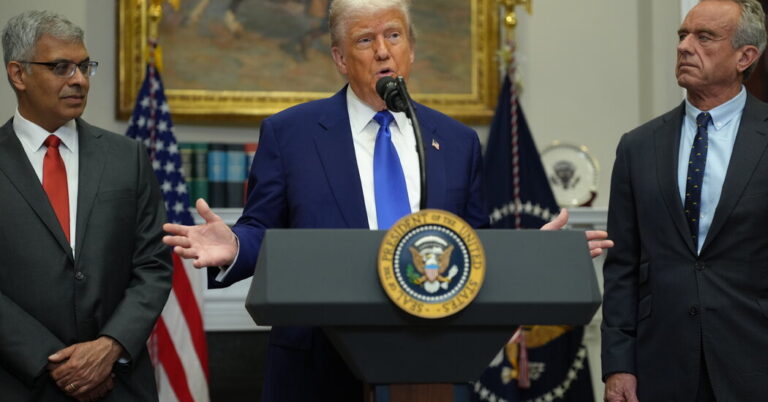President Trump on Monday signed an executive order asking drugmakers to voluntarily reduce the prices of key medicines in the United States.
But the order cites no obvious legal authority to mandate lower prices. The order said the administration would consider taking regulatory actions or importing drugs from other countries in the future if drugmakers do not comply.
It was something of a win for the pharmaceutical industry, which had been bracing for a policy that would be much more damaging to its interests.
Last week, Mr. Trump hyped a coming announcement that was “as big as it gets.” And on Sunday evening, he teed up the order in a Truth Social post, writing that he would link U.S. drug prices to those in peer countries under a “most favored nation” pricing model — a policy he attempted unsuccessfully in his first term for a small set of drugs in Medicare.
His executive order on Monday does not do that. Pharmaceutical stocks rose Monday on the news.
Mr. Trump’s executive order came just hours after House Republicans offered an expansive set of health care policy changes that would cut around $700 billion from Medicaid and the Obamacare marketplaces over a decade and would cause an estimated 8.6 million Americans to become uninsured. Congress declined to include any provisions to directly limit drug prices in that package.
The executive order also called on federal agencies to investigate why European countries get lower prices and to push them to pay more. The Trump administration has limited leverage to drive up prices in Europe.
“I’m not knocking the drug companies,” Mr. Trump said on Monday before signing the order. “I’m really more knocking the countries than the drug companies.”
With his executive order, Mr. Trump opted not to propose measures that could have had more teeth, such as calling for his administration to work with Congress on legislation or writing regulations to change how government health programs pay for some drugs.
“The executive order reads more like an aspirational statement than a serious attempt to initiate a policy change,” said Ameet Sarpatwari, who studies pharmaceutical policy at Harvard Medical School.
Many Republican lawmakers oppose controls on drug prices, but Mr. Trump has long railed against the current system, in which pharmaceutical companies charge the United States significantly higher prices than the rest of the world.
“We’re going to help the drug companies with the other nations,” he said at Monday’s event.
Mr. Trump threatened to use trade policy to push European countries to pay more for prescription drugs. But drug companies are already locked into contracts with governments, and if they try to charge more for new medicines, European countries may balk at covering them at all. And higher prices in Europe would not necessarily lead to lower prices in the United States, drug pricing experts warned.
In his first term, Mr. Trump tried unsuccessfully to enact a more substantive policy to reduce some drug prices paid by Medicare, the health insurance program for Americans who are over 65 or have disabilities. That plan would have applied only to 50 drugs, administered at clinics and hospitals. A federal court blocked it, ruling that the administration had skipped steps in the policymaking process.
It is not clear whether that policy could have passed legal muster had it been pursued by the book. In interviews, some experts said Mr. Trump would have needed Congress to pass a law.
The White House had teased the announcement as seismic. Monday’s executive order, on its face, calls for much broader changes than Mr. Trump proposed in his first term, affecting more drugs and all Americans, not just some Medicare patients. But it lacks a clear mechanism for enacting the price reductions.
“It almost sounds like: We’ll just ask for lower prices and see how that goes,” said Stacie Dusetzina, a health policy professor at Vanderbilt University who studies drug pricing. Barring more substantive action, she said, “I would not anticipate drug prices to come down in the near future.”
The order said that if the initial actions did not make enough progress in lowering U.S. drug prices, the Trump administration may “propose a rulemaking plan to impose most-favored-nation pricing.”
Democrats have introduced numerous bills to bring American prices more in line with those of foreign peers, and legislation passed during the Biden administration allows Medicare to negotiate directly on the price of a limited set of drugs used in the program. In general, policies that would lower drug prices are very popular among both Republican and Democratic voters.
The drug industry has also been bracing for punishing tariffs on imported medicines, which Mr. Trump has vowed to impose soon. Tariffs would most likely drive up some drug prices in the United States and cut into drugmakers’ profits even if they could pass along some of the added costs.
Pharmaceutical investors were relieved that Mr. Trump did not propose the more substantive policy he had threatened. After dropping in premarket trading, pharmaceutical stocks rebounded when the details of Mr. Trump’s move became clear. Merck’s stock rose by 6 percent on Monday. Pfizer’s closed up by nearly 4 percent. An index of smaller biotechnology stocks was up 4 percent.
“Better than feared,” analysts at the Wall Street bank Jefferies wrote in a note to investors. “More bark than bite,” said TD Cowen analysts.
In statements on Monday, lobbying groups for drugmakers said the United States should not look to other countries for how much it pays for drugs.
But the main industry group, PhRMA, also applauded Mr. Trump for threatening to use trade negotiations to push foreign governments “to pay their fair share for medicines.”
“U.S. patients should not foot the bill for global innovation,” said Stephen J. Ubl, PhRMA’s chief executive.
Brand-name drug prices in the United States are three times as high, on average, as those in peer nations.
Drugmakers typically design their business strategy around the substantial profits they bring in from the United States.
Pharmaceutical companies argue that the higher U.S. prices come with added benefits: Industry-funded analyses have found that patients in the United States get medicines faster, and with fewer insurance restrictions, than those elsewhere.
In other wealthy countries, the government generally pays for prescription drugs for the entire population, negotiating substantial discounts from drugmakers. Many other nations do their own comparisons with prices in peer countries to help determine what they are willing to pay.
But in the United States, the government has very little formal involvement in setting drug prices, other than the Biden-era program for a limited number of drugs in Medicare. The Trump administration is now overseeing that program.
This month, Senator Josh Hawley, a Republican from Missouri, and Senator Peter Welch, a Democrat from Vermont, introduced a bill that would limit drug prices in the United States to an average of the prices paid by a group of peer countries.
In an interview, Mr. Welch said he agreed with Mr. Trump that Americans are overpaying and that international comparisons could help set fairer prices. But he thinks Congress needs to tackle the issue to ensure a durable policy.
“It’s really important to do this legislatively,” he said.
Mr. Trump’s executive order gave his administration one month to tell drug companies the voluntary “price targets” for certain medicines. A White House official said that weight-loss medicines known as GLP-1s — a class of popular drugs like Zepbound and Wegovy — would likely be among them.
Mr. Trump complained in his news conference Monday that “the fat shot” costs much less in Europe than in the United States.
In most cases, Americans can get these drugs for $500 a month without using insurance. European pharmacies often charge a few hundred dollars less. Most European patients pay out of pocket for the drugs because their national health systems generally do not cover them.


